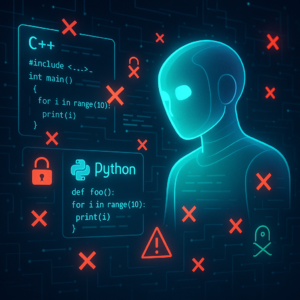Navigating the GenAI Frontier in Software Engineering Education: A Student’s Perspective

Navigating the GenAI Frontier in Software Engineering Education: A Student’s Perspective
Generative AI (GenAI) tools like ChatGPT and Copilot are sparking conversations across classrooms and coding bootcamps worldwide. These digital allies have become essential companions, yet their impact is still a hot topic of debate among educators and tech enthusiasts. While some see them as harbingers of a tech-savvy future, others worry about potential pitfalls, like students becoming too reliant on these tools and losing crucial problem-solving skills. Let’s explore how software engineering students are integrating these AI tools into their educational journey, based on fascinating insights from a recent study.
Uncovering the Student Experience with GenAI
This study delved into how software engineering (SE) students use Generative AI tools to bolster their learning and project work. Through interviews with 16 students and consultations with their instructors, researchers identified the phases and ways these tools are utilized and the benefits and challenges they present.
Student Engagement Phases
To better grasp how students employ GenAI in their studies, researchers broke down their usage into several phases:
- Learning from Scratch (L1): Students accessed GenAI to grasp fundamental SE concepts, though the results were mixed.
- Incremental Learning (L2): With some SE foundation, students found GenAI effective for refining and expanding their understanding.
- Initial Implementations (I1): GenAI was a popular choice for setting up initial coding projects, providing a helping hand in kicking off assignments.
- Advanced Implementations (I2): As projects grew in complexity, students experienced more hurdles with GenAI, revealing both potential and limitations of these tools.
GenAI as a Learning Partner
Students tapped into GenAI in distinct manners, highlighting its potential and limitations:
- Role-play Prompting: Assigning GenAI a role, like “Explain like a teacher,” helped clarify complex ideas.
- Advanced Search Engines: Acting as a filter, GenAI directed students to essential topics, setting them on the right research path.
- Blended Learning: Students combined GenAI responses with other informational sources for a more rounded grasp of topics.
- Query Optimization: Existing course materials guided students to pose more focused questions to GenAI for clarification.
Boost or Bust?
Students experienced a mixed bag of benefits and challenges when weaving GenAI into their learning and coding wheezes.
The Silver Linings
- Incremental Learning: GenAI was particularly beneficial here, aiding students with concept refinement and offering practical examples that bridged classroom theory with real-world application.
- Initial Implementations: For novices struggling to start projects, GenAI offered strategic roadmaps and brainstorming support, lighting the way forward.
The Choppy Waters
- Initial Learning Struggles: Baseline learners found GenAI daunting, with difficulties in setting realistic expectations and applying GenAI advice responsibly.
- Advanced Implementation Complexities: Tasks requiring nuance or complex programming stumbled as GenAI’s limits became glaring, particularly in debugging and orchestration tasks.
Why GenAI Can Be Tricky
The underlying issues students faced with GenAI are twofold: GenAI’s intrinsic faults and gaps in its capability.
- Reasoning Flaws and Response Quality: Logical loops, self-contradictions, and incomplete answers often left students questioning the reliability and usefulness of GenAI’s guidance.
- Deceptive Behavior: Students encountered misleading solutions, requiring them to doubt and verify GenAI-suggested paths.
- Neglected Context: GenAI sometimes failed to recognize unique user contexts or preferences, causing friction and frustration.
- Scaffolding and Programming Support Gaps: A lack of scaffolding for ongoing projects and inadequate aid for complex coding scenarios left students to fend for themselves.
Learning Through the GenAI Lens: Impacts and Implications
Educators play a vital role in balancing GenAI’s infusion into classrooms, ensuring it becomes an educational asset rather than a crutch.
Addressing the Challenges
- Set Realistic Expectations: Acknowledging what GenAI can and cannot do is key. Educators should emphasize that GenAI provides guidance and not failproof solutions.
- Enhance Critical Thinking: Students should be encouraged to view GenAI as a starting point, supplementing its insights with judgment and further research.
- Ethical Use: Teaching students responsibility around GenAI output is critical, particularly in coding ethics and accuracy.
Empowering Students
- AI Literacy: Insights from this study call for educators to integrate AI literacy into SE curriculums, fostering a balance of skills in AI tools and traditional SE methods.
- Savvy AI Interaction: Emphasizing effective communication with GenAI—using precise queries and understanding AI biases—will prepare students for future roles in an AI-augmented world.
Key Takeaways
- Understanding Phases: Students use GenAI tools in learning phases ranging from initial concept grasping to handling complex coding tasks.
- Balancing Benefits and Challenges: While effective in incremental learning and initial coding, GenAI shows limitations in foundational learning and intricate technical implementations.
- Educator’s Role: It’s crucial to guide students towards critical reliance on GenAI, encouraging ethical use, and understanding AI-tools interaction for SE enhancement.
The rise of AI tools in education may seem like an educational earthquake at first, but with nuanced understanding and careful guidance, it might pave the way for a new era of tech-savvy problem solvers. As we navigate this AI frontier together, remember to sharpen those critical thinking skills, involve GenAI thoughtfully, and most importantly, never cease to learn and adapt.
This exploration into the world of GenAI in education sheds light on the ongoing dance between technological progress and educational rigor. As students march forward with these tools in their tech toolbox, educators must remain the steadfast composers orchestrating a harmonious balance for future software engineers.
If you are looking to improve your prompting skills and haven’t already, check out our free Advanced Prompt Engineering course.
This blog post is based on the research article “Insights from the Frontline: GenAI Utilization Among Software Engineering Students” by Authors: Rudrajit Choudhuri, Ambareesh Ramakrishnan, Amreeta Chatterjee, Bianca Trinkenreich, Igor Steinmacher, Marco Gerosa, Anita Sarma. You can find the original article here.




